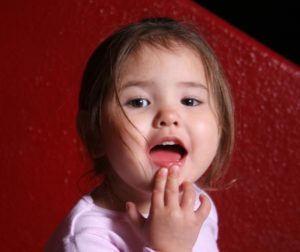 The child's refusal to eat, causeless vagaries, fever and the appearance of painful sores in the mouth - all these symptoms accompany such an unpleasant disease as stomatitis.
The child's refusal to eat, causeless vagaries, fever and the appearance of painful sores in the mouth - all these symptoms accompany such an unpleasant disease as stomatitis.
To quickly help the baby, it is important to correctly diagnose the type of pathology and start therapy as soon as possible.
Features of treatment of stomatitis in children depend on the type of disease and the causes that caused it. Most often, the susceptibility to a particular type of pathology is determined by the age of the child and looks like this:
- from newborns and up to three years of age babies often suffer from candidal stomatitis;
- 1-3 years - there is a tendency to herpetic stomatitis;
- 7-15 Years - often there is an aphthous stomatitis.
With regard to bacterial, viral and traumatic stomatitis, it occurs at any age.
 Regardless of the type of pathology, it is possible to single out one common cause of the development of the disease: inadequate hygiene, easy trauma to tender baby mucosa and insufficient active functioning of the immune system.
Regardless of the type of pathology, it is possible to single out one common cause of the development of the disease: inadequate hygiene, easy trauma to tender baby mucosa and insufficient active functioning of the immune system.
Young children in saliva do not have the necessary amount of enzymes that provide antiseptic action, so unprotected mucosa is open for the negative impact of pathogenic microbes and bacteria.
Contents
- Herpetic stomatitis
- Than to help the child?
- Afty stomatitis
- Treatment approach
- Activation of fungus Candida
- Treatment options
- Do not pull dirty hands in the mouth
- Antibiotic Augmentin
- Metrogil Denta
- Than to rinse the mouth to relieve inflammation?
- Tantum Verde
- Chlorophyllipt
- Lugol spray
- Traumatic stomatitis
- Than to process a mouth cavity?
- The main rule - do no harm!
Herpetic stomatitis
The development of this type of disorder is associated with the penetration of the herpes virus into the body, which remains forever in the body, provoking relapses of the disease. At the age of one to three years, babies still do not have enough of their own antibodies to fight the virus, so the disease manifests itself in the form of obvious symptoms of intoxication, which are accompanied by:
-

Herpetic stomatitis
high fever;
- dry mouth and inflammation of the gingival tissue;
- appearance in the oral cavity, around the lips of the vesicles;
- at the same time as rashes, chills, headache, nausea;
- enlarge of the submandibular lymph nodes.
If the disease is mild or moderate, it can be treated on an outpatient basis, doing local procedures at home.
Than to help the child?
Several main medicines are used to treat the disease.
Miramistin is an excellent antiseptic, to which most microorganisms, including the herpes virus, are susceptible. In addition to antiseptic it has a regenerating effect. Can be used to treat both older children and toddlers for up to a year.
For older children, the form of solution in the form of a solution in a vial with a nebulizer is especially convenient. In this form, the drug is used for injections( one procedure involves 3 injections).If the agent is used for rinses, the procedure is performed at the frequency described above, using 15 ml of Miramistine.
 The active substance of Viferon is the immune-stimulating and antiviral effect of interferons, vitamins E, C. The drug can be used starting from the first months of life.
The active substance of Viferon is the immune-stimulating and antiviral effect of interferons, vitamins E, C. The drug can be used starting from the first months of life.
Among the available release forms are gels and candles( effective in treating babies).The correct dosage is determined by the attending physician.
When using the gel, the affected mucosa is pre-dried with a gauze swab, after which the agent is gently applied. The duration of the course is about a week.
Often in case of viral stomatitis, an antiviral oxolin ointment is prescribed, but its disadvantage is the form of the release in the form of an ointment, which is poorly fixed on the mucosa, without providing the proper result. Use this tool can only be used to treat sores around the lips or on the lips.
Aphthous stomatitis
To date, doctors can not pinpoint the cause of this disease. Among the possible provoking factors distinguish:
-
 various types of allergies, including food, microbial, medicamentous;
various types of allergies, including food, microbial, medicamentous; - improper functioning of the immune system;
- presence of chronic disorders in the functioning of the digestive system;
- development of staphylococcal infection.
The clinical symptoms of aphthous stomatitis are characterized by the following symptoms:
- fever;
-
 sensation of itching and burning on the mucosa;
sensation of itching and burning on the mucosa; - refusal to eat;
- the appearance of painful white sores, surrounded by a bright red rim( the edges are always clear and smooth);
- formation on the surface of a soft film.
Correct therapy is prescribed after a comprehensive examination involving a gastroenterologist, an allergist and a dentist. Special attention is paid to local treatment.
Treatment Approach
What should I do if a child is diagnosed with this disease?
Vinylinum, which is also called Shostakovskiy's balm, is an effective antiseptic, antimicrobial and regenerating drug. Due to the presence of the polyvinix, the mucous membrane of the oral cavity is disinfected, re-infection of the damaged areas is prevented, tissue regeneration is accelerated, and pain is eliminated.
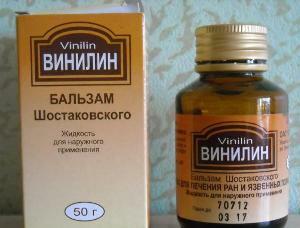 Balm is previously applied to a gauze pad that is applied to the affected areas. The treatment is carried out after eating, eating food and drinks is possible not earlier than 40 minutes later. Three treatments are necessary per day.
Balm is previously applied to a gauze pad that is applied to the affected areas. The treatment is carried out after eating, eating food and drinks is possible not earlier than 40 minutes later. Three treatments are necessary per day.
According to the instructions, the drug is contraindicated for children under 14 years old, but doctors often prescribe it to small patients if they can observe one important condition - do not swallow a remedy.
Also, it is important to constantly assess changes in the state of the child, since the appearance of even minor rashes is the reason for the cancellation of Vinilin.
Iodinol is available as an aqueous solution with active ingredients iodine at a concentration of 0.1%, potassium iodide 0.9%, and polyvinyl alcohol. When mixed with water, the preparation acquires a dark blue color.
By the nature of the action is a strong antiseptic, providing a high anti-inflammatory effect.
To treat the baby's mouth in a glass of water, dissolve a tablespoon of iodine and use a rinse solution for a week 3-4 times a day.
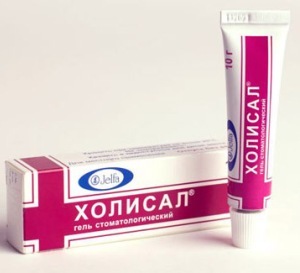 The main active ingredients of holisal gel are choline salicylate and cetalkonium chloride. Along with anti-inflammatory has anesthetic effect. It is not recommended to use in the treatment of children under the age of one year.
The main active ingredients of holisal gel are choline salicylate and cetalkonium chloride. Along with anti-inflammatory has anesthetic effect. It is not recommended to use in the treatment of children under the age of one year.
The product is available as a gel, which is especially effective in the treatment of inflammation of the mucosa.
The drug is applied to the affected areas 2-3 times a day, squeezing out a strip of 0.5 cm long, and gently distribute it along the mucosa by means of light rubbing movements.
Activation of fungus Candida
The cause of the development of fungal stomatitis is Candida yeast-like fungus, which normally is present in a small amount in the oral cavity of all people and is activated in favorable conditions( decreased immunity, maintenance of acidic medium).Characteristic symptoms include:
-
 increased lymph nodes and increased temperature to critical values;
increased lymph nodes and increased temperature to critical values; - appearance in the oral cavity of curdled white or gray plaque;
- excessive capriciousness, poor appetite, restless sleep;
- soreness of foci of inflammation;
- sensation of burning, itching and dryness of the mucosa;
- , when the plaque is removed, a reddened or bleeding area opens.
The aim of the local treatment is the formation of an alkaline medium in the oral cavity, which prevents reproduction of the fungus.
Therapy options for
How to help a child?
Sodium tetraborate reduces the vital activity of fungi, reducing their ability to fasten to the mucosa. The presence of glycerol reduces inflammation.
If the baby sucks a pacifier, before going to bed it is also rubbed with a medicine for stomatitis. When signs of stomatitis completely go away, the treatment is carried out a couple of days.
 Nystatin is an antifungal medicine. Cautiously assigned to young children due to a large number of contraindications.
Nystatin is an antifungal medicine. Cautiously assigned to young children due to a large number of contraindications.
For infants, the drug is used in the form of an aqueous solution, pouring powdered pill into a glass of slightly warm boiled water. The solution is wetted wound on the finger bandage and wipe the mouth of the child after eating( for a day, the procedure is at least 4 times).
Older children can use Nystatin in tablets, dissolving them behind their cheeks. The daily dose chosen by the doctor is divided into 3 doses, the course of treatment is 14 days.
Fluconazole is indicated for use in the treatment of children older than 5 years. It is especially effective if other methods of local therapy are not effective or the disease proceeds in chronic form.
The maximum daily dose is 3 mg per kg of child weight. The duration of therapy depends on the condition of the child and is determined by the attending physician.
Fungal infection is effectively eliminated by rinses, for which a couple of teaspoons of soda are dissolved in a glass of water.
Number of procedures per day - at least 4. When treating young children, mucosal treatment is carried with a gauze swab dipped in the solution.
Do not pull dirty hands into the mouth
Bacterial stomatitis is called a disease of dirty hands. Especially prone to pathology are young children, who are actively learning the world around, trying everything on the palate.
The cause of inflammation is the penetration of bacteria into the wounds on the mucosa( cracks, scratches).
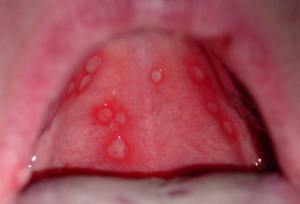
Bacterial stomatitis
At the onset of the inflammatory process in a child, the temperature rises and the following symptoms are observed:
- formation on the mucosa of a plaque of gray-yellow color;
- formation of pus filled with pus or bloody contents;
- appearance of bad breath;
- formation on the layers of layers in the form of dry crusts of yellowish color.
Local treatment should begin in the first days of illness. At the same time, every two hours and immediately after meals rinse your mouth, clearing the mucous membranes from bacteria.
If the disease is diagnosed in a newborn baby, rinses are replaced by irrigation, which is done by putting the baby on its side. For the main therapy, antibiotics and local antiseptics are used.
Antibiotic Augmentin
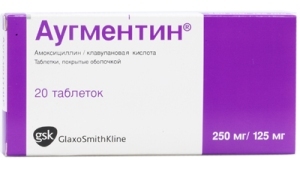 It is a semisynthetic antibiotic of the penicillin group and is used as a last resort in severe process. The main active substances of Augmentin are clavulanate and amoxicillin. Among the available forms of release are tablets, powder for injections or suspensions, syrup.
It is a semisynthetic antibiotic of the penicillin group and is used as a last resort in severe process. The main active substances of Augmentin are clavulanate and amoxicillin. Among the available forms of release are tablets, powder for injections or suspensions, syrup.
Antibiotics for stomatitis in a child are often prescribed as a suspension. The dose is determined by the attending physician, who is guided by the condition of the small patient and his age.
Amoxicillin is not allowed in the treatment of infants less than 2 months of age.
Metrogyl Denta
 The gel-releasing agent is well fixed on the mucosa, providing maximum impact on the affected areas. Ingredients are an antibiotic and an antiseptic, so Metrogil Denta has a double effect. The drug is not prescribed for children under 6 years.
The gel-releasing agent is well fixed on the mucosa, providing maximum impact on the affected areas. Ingredients are an antibiotic and an antiseptic, so Metrogil Denta has a double effect. The drug is not prescribed for children under 6 years.
For the treatment of inflamed areas, the gel is applied directly to the sores using a cotton swab or a clean finger.
Than to rinse out a mouth for putting off or taking out of an inflammation?
For bacterial stomatitis, sprays for rinsing the oral cavity are widely used.
Tantum Verde
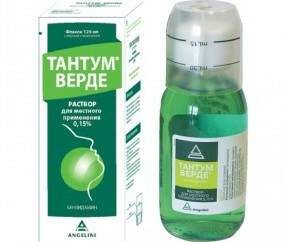 The main active ingredient is benzydamine hydrochloride, which effectively eliminates inflammation in the oral cavity. As a result of local irrigation, pain is reduced, the severity of the inflammatory process is reduced, and the edema of the tissues is reduced. The spray is recommended for use in children of different ages in the following dosages:
The main active ingredient is benzydamine hydrochloride, which effectively eliminates inflammation in the oral cavity. As a result of local irrigation, pain is reduced, the severity of the inflammatory process is reduced, and the edema of the tissues is reduced. The spray is recommended for use in children of different ages in the following dosages:
- less than 6 years old - 1 dose per 4 kg of body weight( no more than 4 doses).Irrigation frequency - every three hours;
- 6-12 years - one dose is used once;
- older than 12 years - 4-8 doses of the agent are injected every 3 hours.
If the drug is used in the form of tablets, the amount of resorption per day should be at least 3.
For rinses, apply the solution, using for one procedure a tablespoon of the drug.
Chlorophyllipt
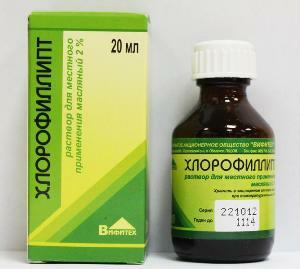 Is a wound healing and bactericidal agent with an active substance in the form of a mixture of chlorophylls extracted from branches and leaves of eucalyptus.
Is a wound healing and bactericidal agent with an active substance in the form of a mixture of chlorophylls extracted from branches and leaves of eucalyptus.
It is most convenient to use a spray that is applied twice a day, achieving relief after only one day.
Also, it is possible to treat the oral cavity with an oil solution of the agent, applying it on a cotton swab, or use chlorophyllipt for rinsing.
Lugol Spray
Is iodine containing agent, which contains glycerol and potassium iodide. It is indicated for use to children older than 5 years. Frequency of use per day - 4-6 times.
Traumatic stomatitis
It is the result of thermal or chemical burns of the oral cavity, its damage by scratching and sharp objects( including teeth), biting the tongue. Often traumatic stomatitis accompanies teething.
At the initial stage is manifested as a slight puffiness of the injured area and its redness, soreness. After a couple of days in the absence of treatment, inflammation develops with a general malaise, an increase in temperature. Therapy involves carrying out local treatment with antiseptics and wound-healing agents.
Than to process a mouth?
In this case, use the following medicines.

Solcoseryl gel - the main active substance is the deproteinized blood extract of calves. Also, the composition contains healing components, anesthetics.
The drug is used immediately after eating, having previously disinfected the affected area. The gel is applied to the site of inflammation with a thin layer and left for 15 minutes. On the day the procedure is carried out at least 3 times.
The duration of treatment and frequency of use can be adjusted by the attending physician depending on the condition of the child.
Chlorhexidine belongs to antiseptics, so it is indicated for traumatic stomatitis to prevent the development of infection in the wound. Chlorhexidine is prescribed only by the attending physician, especially cautiously it should be used to treat children younger than 7 years.
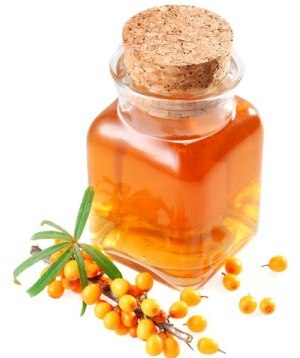 Sea buckthorn oil - high effectiveness of the remedy is observed in the treatment of young children. To achieve the most positive result, it is possible, mixing sea buckthorn oil with encapsulated vitamins B12 and A.
Sea buckthorn oil - high effectiveness of the remedy is observed in the treatment of young children. To achieve the most positive result, it is possible, mixing sea buckthorn oil with encapsulated vitamins B12 and A.
. Such vitamin complexes are used for applications, applying a remedy on a cotton swab and applying it for 5 minutes to the affected area.
Eating food and drinks is allowed an hour after the end of the procedure.
The main rule - do no harm!
There are means, which in no case can not be used in children's stomatitis.
Here it is necessary to allocate such preparations, as zelenka and fukortsin, and also, honey.
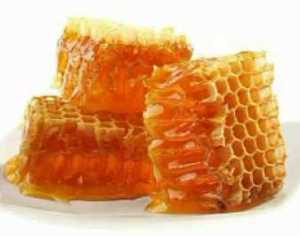 Many parents mistakenly regard honey as an absolutely safe natural antiseptic. Its use for the treatment of small children is not recommended because of the risk of developing a severe allergic reaction.
Many parents mistakenly regard honey as an absolutely safe natural antiseptic. Its use for the treatment of small children is not recommended because of the risk of developing a severe allergic reaction.
In addition, honey creates a favorable environment for the reproduction of staphylococcus, so it can exacerbate the manifestations of stomatitis.
In this pathology, the oral mucosa is strongly irritated, as a result of which the use of alcoholic infusions in the form of fucocine or zelenka can lead to its burns and drying, which will only exacerbate the situation.
Another disadvantage of fucocine is the presence in its composition of a phenol dangerous for babies, which can cause poisoning and the development of allergies.
Effective treatment of stomatitis in children is possible only with the correct diagnosis and timely response to the situation. It is important to conduct therapy in a comprehensive manner, without neglecting the procedures and recommendations of the doctor. Then the child will quickly recover, again become active and cheerful without negative consequences for the body.
Popular about stomatitis in children will tell Dr. Komarovsky:
